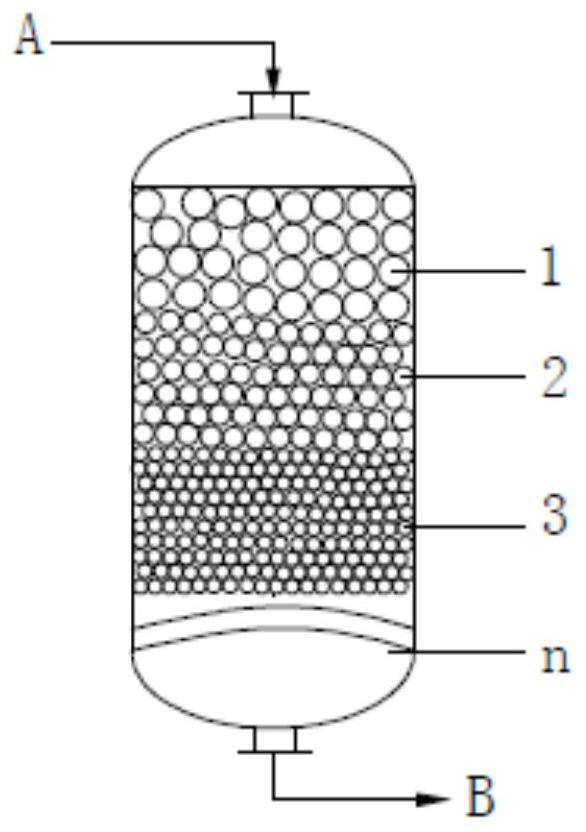A kind of method of loading catalysts with different particle sizes to synthesize propylene oxide
A technology of propylene oxide and catalyst, which is applied in the field of synthesizing propylene oxide by filling catalysts with different particle sizes, can solve the problems of low effective utilization rate of hydrogen peroxide, complex reactor structure, uneven bed temperature, etc., and achieves increased equipment investment and reaction The effect of slow rate and low decomposition rate
- Summary
- Abstract
- Description
- Claims
- Application Information
AI Technical Summary
Problems solved by technology
Method used
Image
Examples
Embodiment 1
[0037] Pack ten kinds of titanium-silicon molecular sieves with different particle sizes along the flow direction of the reaction material according to the particle size arrangement in the table below:
[0038] layers Catalyst particle size d / mm Filling height / mm d n / d n+1
[0039] Control the molar ratio of hydrogen peroxide: propylene: methanol to be 1:5:20, and the space velocity of the total liquid weight is 20h -1 Pump into the tubular fixed-bed reactor, the circulating water inlet temperature is 45°C, and the reaction pressure is 4.0MPa. The highest point temperature of the catalyst bed was 54°C, the lowest point temperature was 46°C, and the bed temperature rose by 8°C as detected by a thermocouple. The analysis results showed that the conversion rate of hydrogen peroxide was 99.5%, and the yield of propylene oxide was 92.7%.
Embodiment 2
[0041] Two kinds of titanium-silicon molecular sieves with different particle sizes are packed in the following table along the flow direction of the reactant material:
[0042] layers Catalyst particle size d / mm Filling height / mm d n / d n+1
[0043] Control the molar ratio of hydrogen peroxide: propylene: methanol to be 1:1:5, and the space velocity of the total liquid weight is 5h -1 Pump into the tubular fixed-bed reactor, the circulating water inlet temperature is 50°C, and the reaction pressure is 1.0MPa. The highest point temperature of the catalyst bed was 65°C and the lowest point temperature was 55°C as detected by a thermocouple, and the temperature rise of the bed was 10°C. The analysis results showed that the conversion rate of hydrogen peroxide was 98.5%, and the yield of propylene oxide was 91.5%.
Embodiment 3
[0045] Four kinds of titanium-silicon molecular sieves with different particle sizes are packed in the following table along the flow direction of the reactant material:
[0046] layers Catalyst particle size d / mm Filling height / mm d n / d n+1
[0047] Control the molar ratio of hydrogen peroxide: propylene: methanol to be 1:3:15, and the space velocity of the total liquid weight is 10h -1 Pump into the tubular fixed-bed reactor, the temperature of the circulating water is 40°C, and the reaction pressure is 2.5MPa. The highest point temperature of the catalyst bed was 48°C, the lowest point temperature was 41°C, and the bed temperature rose by 7°C as detected by a thermocouple. The analysis results showed that the conversion rate of hydrogen peroxide was 99.6%, and the yield of propylene oxide was 94.2%.
PUM
| Property | Measurement | Unit |
|---|---|---|
| particle diameter | aaaaa | aaaaa |
| length | aaaaa | aaaaa |
| diameter | aaaaa | aaaaa |
Abstract
Description
Claims
Application Information
 Login to View More
Login to View More - R&D
- Intellectual Property
- Life Sciences
- Materials
- Tech Scout
- Unparalleled Data Quality
- Higher Quality Content
- 60% Fewer Hallucinations
Browse by: Latest US Patents, China's latest patents, Technical Efficacy Thesaurus, Application Domain, Technology Topic, Popular Technical Reports.
© 2025 PatSnap. All rights reserved.Legal|Privacy policy|Modern Slavery Act Transparency Statement|Sitemap|About US| Contact US: help@patsnap.com

